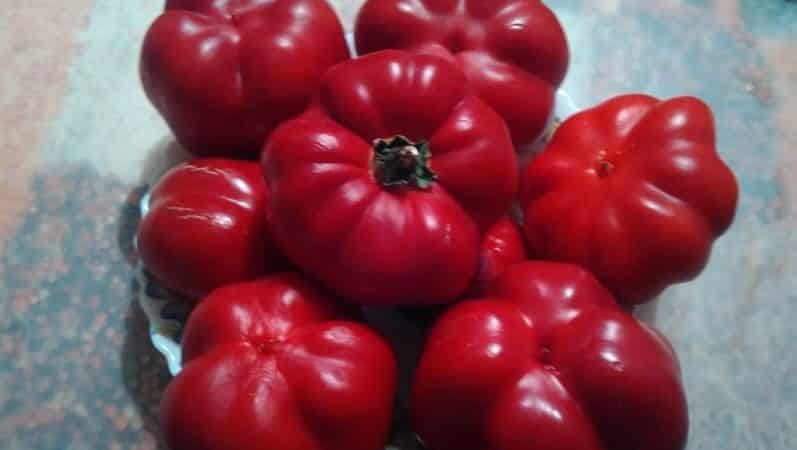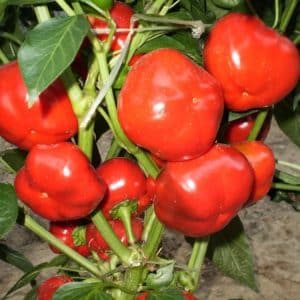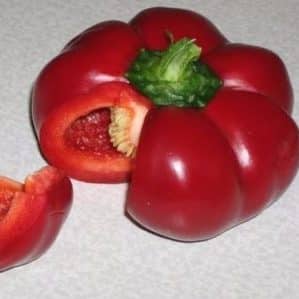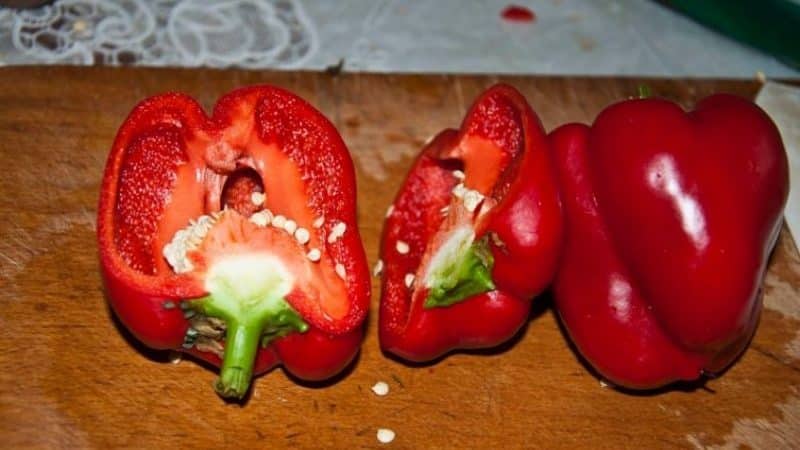Review of the “Novogoshary” pepper variety: reviews from farmers, advantages and disadvantages, nuances of cultivation
Pepper lovers especially value varieties with sweet and juicy flesh. The Novy Goshary variety is one of these peppers, characterized by large and fleshy fruits with a pleasant honey flavor. It has many advantages, is suitable for growing in open and protected ground, and even a novice gardener can handle planting and caring for it.
What type of pepper is this?
A group of Gogoshary pepper varieties with pumpkin-shaped fruits was bred by workers at the Research Institute of Moldova. The Novy Goshary variety is its modification, but in many characteristics it is similar to its predecessors.
Characteristics and description of the variety
The mid-season, highly productive Novy Goshary variety is a unique representative of the Solanaceae family. It belongs to standard vegetable crops with a compact root system, has juicy fruits that ripen in 109-113 days.
Ripe fruits are suitable not only for fresh consumption, but also for preparing various dishes, stuffing, whole fruit canning.
Reference! In the southern regions, Novogoshary peppers are often grown in open ground. In northern latitudes, the variety actively bears fruit exclusively in greenhouse or greenhouse conditions.
Distinctive features
The main distinctive qualities of the Novy Goshary variety:
- large pumpkin-shaped fruits;
- lack of bitterness in the pulp;
- semi-spreading, medium-sized bush up to 45-50 cm high;
- intensive fruiting;
- high level of keeping quality and transportability.

Fruit characteristics and yield
The fruits of Novy Goshary pepper are characterized by the following characteristics:
- have a flat-round shape;
- slightly ribbed;
- weight varies between 90-140 g, length - up to 12 cm, wall thickness about 10 mm;
- the color in biological ripeness is red, in technical ripeness it is green or dark green;
- the flesh is fleshy, juicy;
- the skin is dense;
- They have excellent taste, aroma and an optimal level of sweetness.
Up to seven fruits can ripen on one bush. And the yield level in greenhouse conditions reaches 4 kg per 1 sq. m.
Attention! Novogoshary ripens in several stages. During one growing season, you can collect fruits from each plant several times.
Preparation for cultivation
Experts recommend using the following as planting soil for pepper:
- Peat soil. It is made from two parts peat (or humus) and one part turf soil.
- A soil mixture of three ingredients. In a 1:1:1 ratio, mix high-quality garden soil with a neutral density level, rotted cow manure and sand, which is used to loosen the soil.
Reference! If the soil in the garden plot is clayey and dense, it is advisable to add it in small quantities to the soil mixture. This will create conditions similar to natural ones for the formation of a strong root system.
Before planting, the soil is additionally prepared. Important processing steps:
- decrease in acidity level - this indicator should not exceed 6.5 pH. In case of severe oxidation, dolomite flour, chalk or fertilizers containing ammonium sulfate are added to the soil;
- antibacterial treatment is a guarantee that the plant will not get sick.It is carried out with hot water, in the oven for a quarter of an hour, or with a weak solution of potassium permanganate.
Seed material also needs to be disinfected and stimulated development:
- Seed disinfection. Produced by treating with water at a temperature not lower than +60°C for 10 minutes or heating under a lamp. Or the seeds are kept for 20 minutes in a weak solution of potassium permanganate or Previcur, Polycarbacin, Vitavax.

- Soak in growth simulator for 24 hours. “Bioglobin”, “Radifarm”, “Rostconcentrate”, “Oracle”, “Vympel” or a solution of sodium humate with a temperature of about +25 ° C are suitable, ensuring uniform development of plants, increasing protective functions and productivity, and an antibacterial effect.
- Two-hour treatment with Azotofit solution. It is prepared at the rate of 5 ml per 0.5 liter of water and ensures the activation of nitrogenous bacteria and the improvement of planting material.
- Germination. The seeds are placed in a warm place and covered with damp gauze or a towel, then wrapped in plastic.
Reference! Germination is necessary to select the strongest and most productive pepper seeds. They are the ones who will sprout first.
Growing seedlings (with and without picking)
Sowing seeds in the soil makes sense only in the southern regions of the country. In temperate and northern latitudes, pepper is grown only by seedlings.
Important! Sowing seeds for seedlings is carried out 8-10 weeks before planting in a permanent place.
Planting pepper
To grow seedlings use:
- wooden boxes;
- food containers;
- special cassettes;
- glasses or peat tablets.
Algorithm of actions:
- Select sprouted seeds.
- Fill suitable containers with soil mixture.
- Moisten the soil with a spray bottle.
- Plant seeds to a depth of 1.5 cm.If further picking is planned, then the plants are planted at a distance of 2-3 cm from each other.
- Lightly sprinkle soil on top. Do not compact.
- Spray again with a spray bottle.
- Cover with plastic wrap or glass to create an optimal microclimate.
- Place in a warm and well-lit place with an air temperature of +21-26°C, preferably on a windowsill on the south side.
- Seven days after the first shoots appear, move the containers to a room with a temperature of about +18°C to prevent the seedlings from stretching.
Since pepper has a fragile root system, it is not advisable to pick seedlings. You can plant sprouted seeds in 1-2 pieces. immediately into peat tablets or separate containers with a volume of up to 200 ml, which should be enough for the initial development of the culture. As soon as the seedlings have lateral roots, they are transferred to a half-liter container. This is necessary for the development of the root system and optimal nutrition.
Reference! The first shoots may appear above the ground within 7-10 days. This period depends on the quality of the planting soil and growing conditions.
Further care
Caring for seedlings consists of the following steps:
- Maintaining temperature conditions not lower than +16-18 °C.
- Control of daylight hours. If it is less than 12 hours, it is increased with the help of phytolamps.

- Picking seedlings in the phase of two or three true leaves. When planting in a common container, the plants are thinned out and the weakest ones are removed. To do this, insert a sharp skewer into the soil, trim the lower part of the root and carefully pry up the seedling. If the seeds were planted in separate containers or peat tablets, diving is not carried out.
- Regular watering - at least once every seven days.The soil should be moist, but not swampy.
- Fertilizer application. It is carried out 14 days after germination. The nutrient solution is made from 1 g of urea and 6 g of superphosphate per 2 liters of liquid. The plant is fertilized the second time three days before planting.
Attention! When grown in peat tablets, the plant does not need to be fertilized.
Features of growing the variety and possible difficulties
Novy Goshary peppers fully develop only if certain conditions are met. Seedling bushes are moved to open ground a few weeks after the last spring frost, when the night temperature reaches +12-15°C.
Suitable period: mid-June. It is advisable to transplant into a greenhouse or greenhouse in early or mid-May.
In loamy soil, which provides better access to oxygen, plants are planted at a distance of 20 cm from each other, leaving row spacing within 60 cm. Before planting the bush, each hole is filled with a liter of water, after which the soil is mulched, covering it with straw or spruce branches.
When growing the Novogoshary variety, the following difficulties are possible:
- excessive growth of leaves, which will interfere with normal air exchange and cause various diseases. In this case, the crown of the bush is formed by cutting off excess leaves;
- under the weight of the fruit, the bush bends towards the ground, and the stem becomes deformed. A garter to a support will help solve the problem;
- death due to excessive watering. Too frequent and intense watering leads to leaching of useful substances from the soil and increases the risk of the appearance of pathogenic microorganisms that cause infection of the stem or rotting of the root system.Irrigation is carried out 2-3 times every 7 days and only if the top layer of soil is sufficiently dry. In this case, the soil should be saturated with moisture to a depth of 15 cm, along the entire length of the root;
- weakening of pepper due to lack of essential microelements. Feeding will help. It is carried out with organic or synthetic fertilizers during planting, at the time of flowering or formation of ovaries. For typical feeding, a solution of 30 g of potassium, 15 g of ammonium nitrate and 50 g of superphosphate, diluted in 10 liters of water, is used.
The Novogoshary variety has a number of features that affect the efficiency of its cultivation:
- Small roots. A strong gust of wind can easily tear a bush out of the soil. Regular loosening of the top layer and hilling will help prevent this; nutrients will easily flow to the root and strengthen it.
- Extreme requirement for heat. Pepper develops at a temperature of about +25°C, and when it decreases even by 5 degrees, there is a lag in development and ripening time.
- Photophilousness. The Novy Goshary variety loves sunny areas, which often leads to burns. To avoid this, it is recommended to make the bed in a place where the light intensity changes throughout the day.
Reference! When planted next to other varieties of pepper, cross-pollination is possible. The result will be hybridized fruits with a bitter taste.
Typical diseases and pests
The variety has average immunity to most diseases. But excessive humidity and elevated air temperatures lead to weakening of protection functions and damage by insects.
Most often, pepper suffers from the following pests and ailments:
- Aphid. It sucks the juice out of the plant, leaving a sticky coating on the surface of the leaves - a breeding ground for the development of soot fungi. The parasite is removed by spraying with a soap solution or “Phosbecid” prepared at the rate of 5 ml per 5 liters of water.
- Colorado beetle. This insect affects not only potatoes, it can also move to peppers, especially if they grow nearby. For treatment, the drugs “Aktara” and “Prestige” are used.
- Late blight. It is characterized by a sudden process of wilting, shedding of leaves, and damage to blood vessels. In this case, diseased plants are eliminated, and the soil is treated with a solution of potassium permanganate or the drug “Planriz”.
- Blackleg. Most often it occurs at the moment of emergence of seedlings, determined by the darkening of the root collar and the black constriction in the lower part of the stem. It is recommended to remove infected plants immediately.
- Gray rot. It is characterized by the appearance on the stem in the area of contact with the soil of wet brown spots with a grayish coating. At an early stage, the plant is sprayed with activated carbon diluted in water, chalk or garlic tincture (30 g of grated garlic per 5 liters of liquid). In the advanced stage, diseased plants are immediately eliminated, and healthy ones are replanted.
Any illnesses It's always easier to prevent than to treat. Preventive measures:
- primary antibacterial treatment of seeds and soil;
- ensuring air circulation in the room with seedlings;
- compliance with crop rotation;
- timely watering and picking;
- removal of affected areas;
- introducing biological preparations into the soil, for example, Trichodermin;
- treatment of crops with a solution of copper sulfate (3%) and fungicides.
Attention! To prevent any diseases from being transmitted to peppers, do not plant them where potatoes or tomatoes grew. The best predecessors are cabbage, onions, cucumbers, carrots, and beets.
Advantages and disadvantages of the variety

Novy Goshary is a universal variety with a lot of advantages, which include:
- large-sized fruits with fleshy pulp and a pleasant taste without bitterness;
- high level of productivity;
- resistance to deformation during transportation;
- long shelf life, possibility of ripening indoors.
But there are also a number of disadvantages.
Firstly, demands on temperature and light conditions and growing conditions. The plant produces a harvest when grown in nutritious soil and prefers greenhouse conditions, although with the height of the bush it is more practical to plant it in open ground. As temperatures and light levels drop, development slows down and yields drop.
The second disadvantage is the fragility of the root system and stem fragility. The root is too close to the surface, the plant is not securely held in the ground, so it may fall out and die. The stem is prone to deformation under the weight of the fruit and may break without a garter.
Reviews
There are many reviews on the Internet about the Novy Goshary variety, and most are positive.
Valentina, Omsk: “I would classify the Novy Goshary sweet pepper as excellent varieties. It has several significant advantages. I’ll list it in order of importance for me: this is a “meaty” pepper – the wall thickness reaches one centimeter! Simply luxurious peppercorns! Pepper ripens within 109-113 days from the moment of germination, that is early variety. Suitable for fresh consumption, straight from the garden; it can be stuffed or preserved for the winter.”
Ilya, Barnaul: “I sow seedlings in March, at the beginning of the month. I transplant strong seedlings into greenhouses in May-June. And then I harvest in July, August and September. I think if you have a greenhouse, then this type of pepper is worth growing.”
Tatyana, Krasnoyarsk: “Novogoshary pepper is a super excellent variety! I have been growing it in a greenhouse for three years and am very pleased. In our harsh climate (summer is short), the pepper is fruitful, thick, almost has time to ripen on the vine, juicy, and can be stored well. This pepper has taken a permanent place in my collection.”
Conclusion
The advantages of Novy Goshary peppers, in particular the excellent taste and versatility of fruit processing, outweigh all its disadvantages. The variety is suitable for cultivation in various regions of the country, as it develops well both in open ground and in a greenhouse. And if you follow the basic rules of planting and care, it will give you a rich harvest.